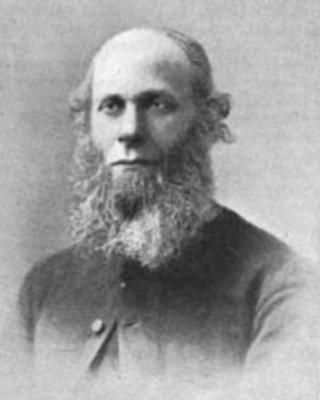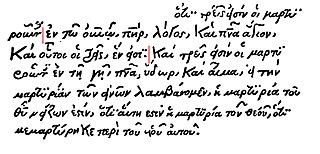
Codex Usserianus Primus (Dublin, Trinity College Library, 55) is an early 7th-century Old Latin Gospel Book. It is dated palaeographically to the 6th or 7th century. [2] It is designated by r (traditional system).

Codex Usserianus Primus (Dublin, Trinity College Library, 55) is an early 7th-century Old Latin Gospel Book. It is dated palaeographically to the 6th or 7th century. [2] It is designated by r (traditional system).
The manuscript is damaged, with the leaves being fragmentary and discoloured. The remains of the approximately 180 vellum folios have been remounted on paper. It contains the text of the Pericope Adulterae as do many Old Latin manuscripts of the Italian branch. It contains some lacunae (Matthew 1:1–15:16; 15:31–16:13; 21:4–21; 28:16–20; John 1:1–15; Mark 14:58–15:8; 15:29–16:20). [3] It names the two thieves crucified with Jesus as, Ioathas and Capnatas (Luke 23:32).
The order of Gospels is Western: Matthew, John, Luke, and Mark. [2] It represents European Old Latin recension. [4]
The manuscript has a single remaining decoration, a cross outlined in black dots at the end of the Luke (fol. 149v). The cross is between the Greek letters alpha and omega. It is also flanked by the explicit (an ending phrase) for Luke and the incipit (first few words) for Mark. The entire assemblage is contained within a triple square frame of dots and small "s" marks with crescent shaped corner motifs. The cross has been compared to similar crosses found in the Bologna Lactantius, the Paris St. John, and the Valerianus Gospels. Initials on folios 94, 101 and 107 have been set off by small red dots. This represents the first appearance of decoration by "dotting" around text, a motif which would be important in later Insular manuscripts.
There are some paleographic similarities with early manuscripts produced at the monastery at Bobbio, such as the Ambrosiana Jerome and the Ambrosiana Orosius. However, it is now thought to have been produced in Ireland. It may therefore be the earliest surviving Irish codex.
The manuscript's traditional name can be translated as "the First Book of Uss(h)er" and refers to James Ussher, Archbishop of Armagh. Despite the name, it is doubtful that Ussher ever actually owned the manuscript.
The text of the codex was collated in 1884 by T. K. Abbott who also gave the manuscript its name. [5]
Currently it is housed at Trinity College (55) at Dublin [2] and can be read online using the Digital Collections portal of the Trinity College library.

The Codex Vaticanus, designated by siglum B or 03, δ 1, is a fourth-century Christian manuscript of a Greek Bible, containing the majority of the Greek Old Testament and the majority of the Greek New Testament. It is one of the four great uncial codices. Along with Codex Alexandrinus and Codex Sinaiticus, it is one of the earliest and most complete manuscripts of the Bible. The codex has been dated palaeographically to the 4th century.

The Book of Kells is an illuminated manuscript and Celtic Gospel book in Latin, containing the four Gospels of the New Testament together with various prefatory texts and tables. It was created in a Columban monastery in either Ireland or Scotland, and may have had contributions from various Columban institutions from each of these areas. It is believed to have been created c. 800 AD. The text of the Gospels is largely drawn from the Vulgate, although it also includes several passages drawn from the earlier versions of the Bible known as the Vetus Latina. It is regarded as a masterwork of Western calligraphy and the pinnacle of Insular illumination. The manuscript takes its name from the Abbey of Kells, County Meath, which was its home for centuries.

The Book of Mulling or less commonly, Book of Moling, is an Irish pocket Gospel Book from the late 8th or early 9th century. The text collection includes the four Gospels, a liturgical service which includes the "Apostles' Creed", and in the colophon, a supposed plan of St. Moling's monastery enclosed by two concentric circles.

The title Codex Vercellensis Evangeliorum refers to two manuscript codices preserved in the cathedral library of Vercelli, in the Piedmont Region, Italy.

Reverend Thomas Kingsmill Abbott was an Irish scholar and educator.
The Garland of Howth, also known as the Codex Usserianus Secundus, designated by r2 or 28, is a fragmentary 8th to 10th century Latin Gospel Book now in Trinity College Dublin as MS. 56.

Codex Borgianus, designated by T or 029, ε 5, is a Greek and Sahidic uncial manuscript of the Gospels, dated palaeographically to the 5th century. The name of the codex came from its former owners.

Codex Cyprius, designated by Ke or 017, ε71, or Codex Colbertinus 5149, is a Greek uncial manuscript of the four Gospels, written on parchment. It is one of the few uncial manuscripts with the complete text of the four Gospels, and it is one of the more important late uncial manuscripts. It was brought from Cyprus to Paris.
Codex Dublinensis designated by Z or 035, ε 26, is a Greek uncial manuscript of the Gospels, dated palaeographically to the 6th century. The manuscript is lacunose.

Codex Tischendorfianus IV – designated by Γ or 036, ε 70 – is a Greek uncial manuscript of the Gospels, dated palaeographically to the 10th century. The manuscript is lacunose.

Codex Montfortianus designated by 61, δ 603, and known as Minuscule 61 is a Greek minuscule manuscript of the New Testament on paper. Erasmus named it Codex Britannicus. Its completion is dated on the basis of its textual affinities to no earlier than the second decade of the 16th century, though a 15th-century date is possible on palaeographic grounds. The manuscript is famous for including a unique version of the Comma Johanneum. It has marginalia.

Papyrus 97, designated by 𝔓97, is a copy of the New Testament in Greek. It is a papyrus manuscript of the Gospel of Luke. The manuscript has survived in a fragmentary condition.
Minuscule 58, ε 518, is a Greek minuscule manuscript of the New Testament, on parchment leaves. Palaeographically it has been assigned to the 15th century. The manuscript has complex contents. It has marginalia.
Minuscule 63, A 118, formerly known as Ussher 1, is a Greek minuscule manuscript of the New Testament, on parchment leaves. Palaeographically it has been assigned to the 10th century. It has marginalia.
Minuscule 64, ε 1287, formerly known as Ussher 2, is a Greek minuscule manuscript of the New Testament, on parchment leaves. Palaeographically it has been assigned to the 12th century. The manuscript has complex contents and full marginalia.
Minuscule 155, ε 403 (Soden), is a Greek minuscule manuscript of the New Testament, on parchment. Palaeographically it has been assigned to the 13th century. It has marginalia.
Minuscule 178, ε 210 (Soden), is a Greek minuscule manuscript of the New Testament, on parchment. Palaeographically it has been assigned to the 12th century. It has marginalia.
Minuscule 211, ε 234 (Soden), is a Greek-Arabic diglot minuscule manuscript of the New Testament, on parchment. Palaeographically it has been assigned to the 12th century. The manuscript is lacunose. It has marginalia.
The Codex Palatinus, designated by e or 2, is a 5th-century Latin Gospel Book. The text, written on purple dyed vellum in gold and silver ink, is a version of the old Latin. Most of the manuscript was in the Austrian National Library at Vienna until 1919, when it was transferred to Trento, where it is now being kept as Ms 1589 in the Library of Buonconsiglio Castle. Two leaves were separated from the manuscript in the 18th century: one is now in the library of Trinity College, Dublin, the other in the British Library in London.